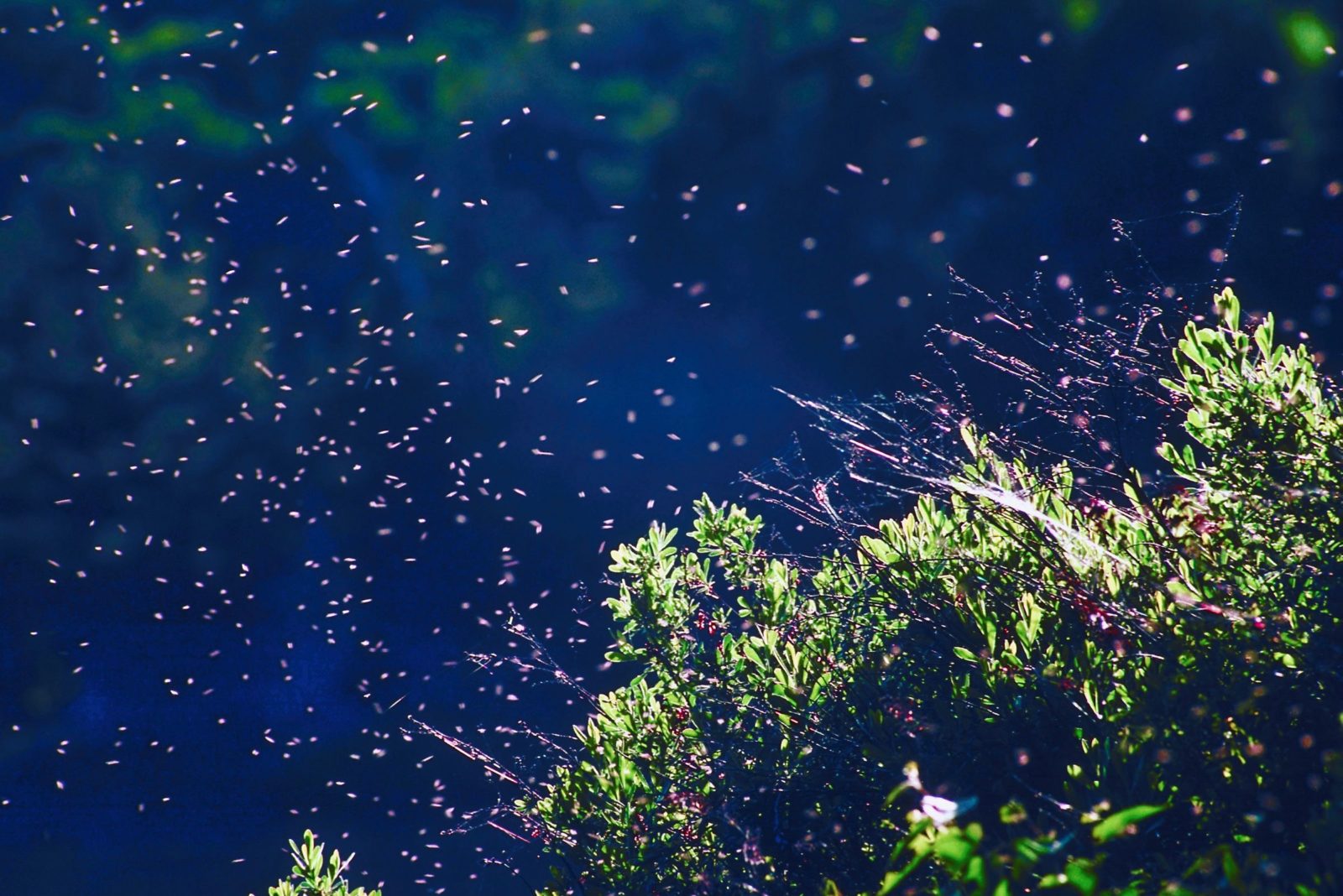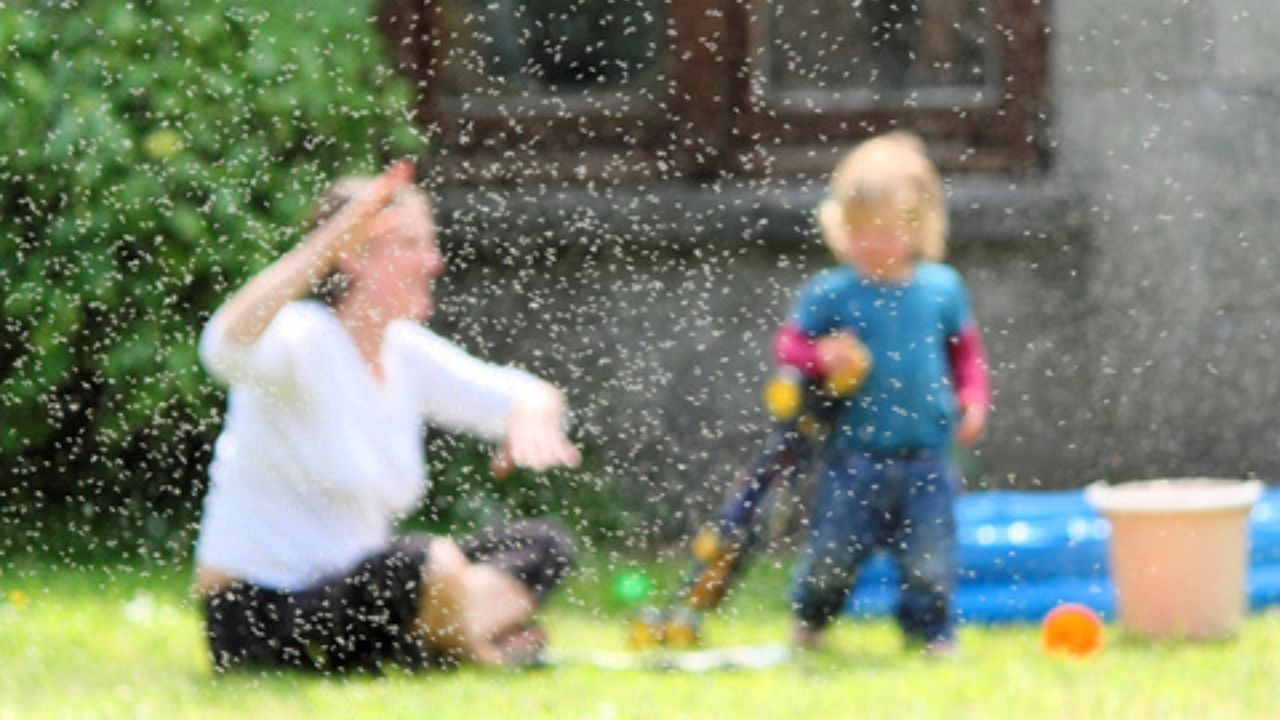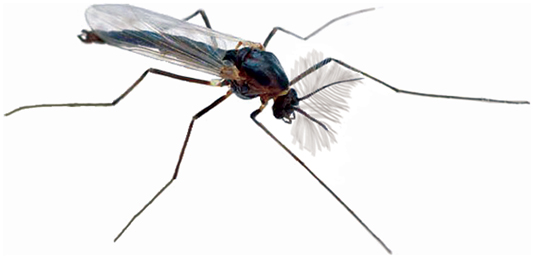
How to Get Rid of Aquatic Midge Flies in Freshwater Ponds
Written by: David Cottrell, District Manager and Botanist
I recently met with a client who recounted a story of a lakefront cookout that was plagued by thousands of swarming insects. The culprits were midge flies and they created a terrible nuisance as neighbors tried to enjoy a beautiful evening together in Northeast Florida. The midges covered all surfaces, including—to the horror of the hosts—the freshly melted cheese adorning their juicy grilled burgers… pizza anyone? The client has a lot of fun with this story now, but the sad reality was that the beautiful setting which attracted them to their fantastic neighborhood was ruined during midge season. Unfortunately, in some parts of the country like Florida, midge fly infestations can last for the majority of the year!
There are two common groups of midges that cause headaches for many waterfront residents. One is often referred to as the bloodworm midge and the other as the phantom or ghost midge. Both groups get their name from their appearance in the larval stage of their lifecycle. While it’s reassuring to know that midges do not bite or spread disease like mosquitoes, they can have a significant impact on the enjoyment of outdoor spaces; they create a mess to clean up, mar painted surfaces, and may even cause problems for asthma sufferers.

The midge fly goes through a lifecycle that starts as an egg laid on or near the surface of the water. The egg hatches and develops into the larval form, which lives within the waterbody. Most species of larvae inhabit the bottom sediments, but some like the phantom midge can also move throughout the water column. The larva transforms into a mobile form known as a pupa that floats to the surface and ultimately morphs and emerges as an adult midge fly. The adult fly doesn’t feed and typically only lives for a few days, although, in some areas adults, can survive for several weeks. This phase lasts just long enough for the insect to seek out a mate, reproduce, and begin the cycle again.
Many property owners attempt to do the obvious and get rid of midge fly swarms by applying pesticides via sprayers, foggers, or misting systems. One quickly learns this approach is expensive and futile as flies are continually emerging in a never-ending stream from the source waterbody. Understandably, most of us would prefer a more environmentally-friendly and sustainable approach to get rid of midges. When asked for alternatives, I often mention to clients that they can take advantage of the fact that adult midge flies are attracted to light colored surfaces and bright lights. I like to kid that one can paint their house a dark color and replace their outdoor lighting with dimmer bulbs, so the flies are attracted to their neighbor’s houses instead.
So, how can you get rid of midge flies this season?
Fortunately, there are effective management strategies that don’t involve continually spraying pesticides, sacrificing one’s weekend painting, or making your neighbor’s midge problem worse. Control of midge flies is best achieved using an integrated, proactive approach that not only targets the pests themselves, but also addresses the underlying issues that make the pond a good host for these critters in the first place.
The larval stage of the midge fly occurs entirely inside the aquatic environment, a fact lake managers can take advantage of to address the insects before they emerge as nuisance adults. It’s a good idea to consult your lake professional for help in planning the valuable first step of conducting a midge larval survey. These assessments are used to identify the type, location, and density of midge larvae present. Armed with this information, an integrated management plan can be developed to address the infestation.
The application of an EPA-registered insect growth regulator and/or bacterial larvicide can be made to reduce the number of larvae when quick results are needed. Timing of treatments is crucial for successful management and needs to be adjusted based on environmental factors such as air and water temperature. This strategy provides only temporary relief as impacts are short lived and numbers will rebound quickly if applications are not performed on an ongoing basis. Resources are limited for many stakeholders and for some it makes sense to direct their dollars toward more sustainable practices. Identifying the underlying issues is key in determining what strategies will provide the most benefit for one’s investment.

One commonly identified issue associated with nuisance levels of midge flies is when the water in a pond does not adequately mix through natural means. When this occurs, the deeper water may become oxygen depleted, a condition referred to as anoxic. This situation provides an advantage for the bloodworm midge larvae, which are specially adapted to live in low oxygen environments. Living in oxygen-depleted zones protects these larvae from being preyed upon by fish unable to tolerate such habitats. Aeration to mix the water column (submersed aeration systems) or direct oxygenation (like nanobubble treatments) provide the circulation and oxygen needed for fish to expand their feeding range to where the larvae reside. Lake and pond aeration coupled with supplemental stocking of fish species such as Shellcracker and Bluegill has proven to be a highly effective and sustainable way to rebalance the ecosystem and reduce midge flies to below nuisance levels.
Another integrated aquatic midge control strategy considers the fact that midge larvae feed on algae, bacteria, and detritus in the water (which are all indicators of poor water quality). A management plan to address algae and the underpinning water quality issues will not only improve the appearance of your waterway but reduce or prevent a midge problem before it develops. A great starting point is a water quality assessment tailored to identify the issues causing the impairment. Such an assessment is also useful in establishing a baseline by which one can measure the success of remediation actions going forward. Excess nutrients such as phosphorus are likely contributors that can be identified through proper testing. Your professional lake manager can develop an integrated program that combines options to control the existing algae along with technologies to make it less hospitable for midges. Pond aeration, mentioned above, is another well-established strategy for helping improve water quality. A properly designed assessment can determine if this augmentation would be a good investment for your aquatic resource.
Aquatic midges are an important part of our ecosystem providing food for fish and other aquatic insects within a pond as well as birds and other animals without. Like most things in nature however, striking a healthy balance is best. When adult midge flies reach nuisance levels, consult your lake management professional for advice on which strategies would be most beneficial in restoring balance to your system. Happy grilling!
Contact Us Today
Complete the form below or call us at 888-480-5253 for all of your lake, pond, wetland and fisheries management needs.
SOLitude Lake Management is a nationwide environmental firm committed to providing sustainable solutions that improve water quality, enhance beauty, preserve natural resources and reduce our environmental footprint. SOLitude’s team of aquatic resource management professionals specializes in the development and execution of customized lake, pond, wetland and fisheries management programs that include water quality testing and restoration, nutrient remediation, algae and aquatic weed control, installation and maintenance of fountains and aeration systems, bathymetry, shoreline erosion restoration, mechanical harvesting and hydro-raking, lake vegetation studies, biological assessments, habitat evaluations, and invasive species management. Services and educational resources are available to clients nationwide, including homeowners associations, multi-family and apartment communities, golf courses, commercial developments, ranches, private landowners, reservoirs, recreational and public lakes, municipalities, drinking water authorities, parks, and state and federal agencies. SOLitude Lake Management is a proud member of the Rentokil family of companies in North America.









